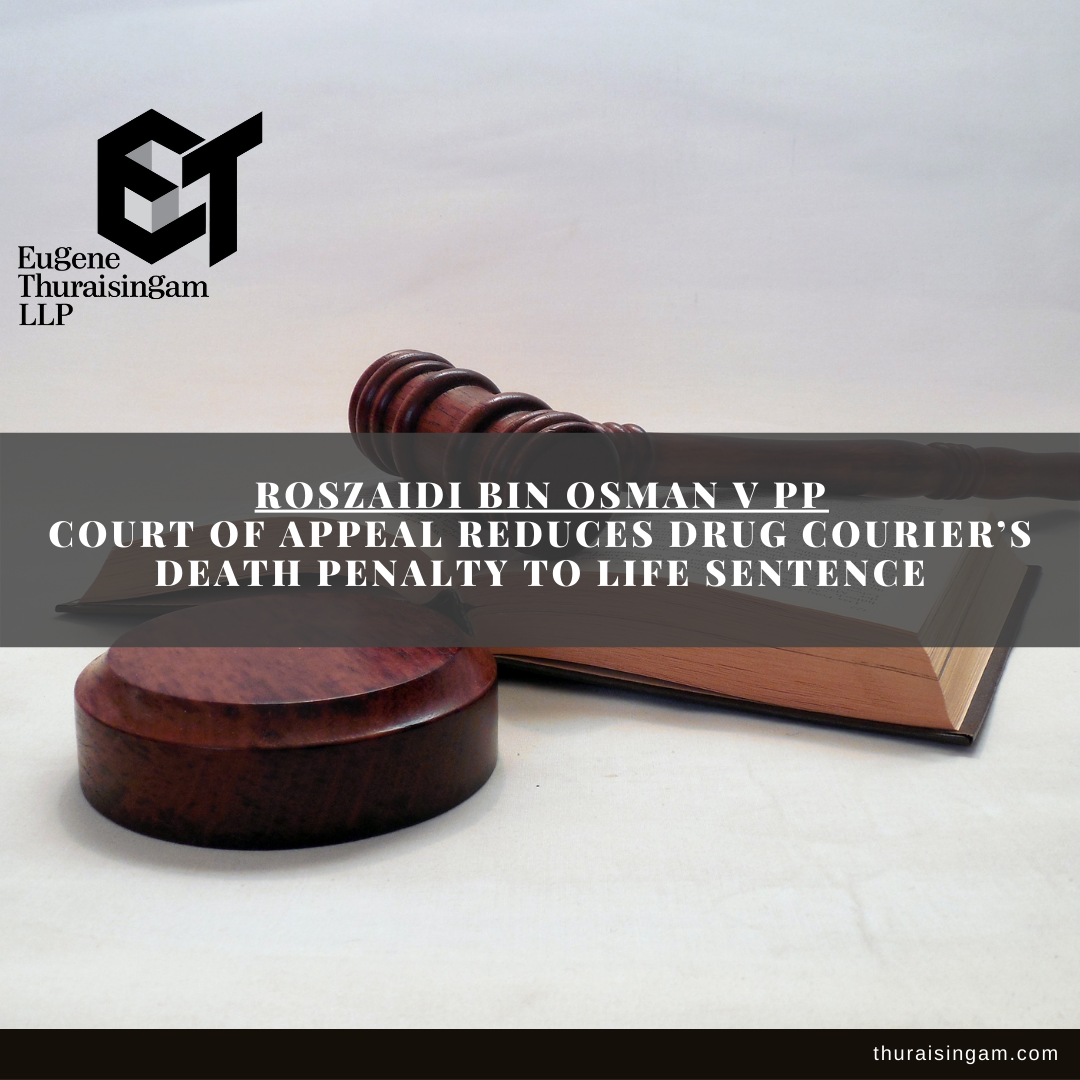PP v Miya Manik – Court of Appeal upholds acquittal of man charged with murder
Public Prosecutor v Miya Manik [2022] SGCA 73
1. Overview
If multiple offenders attack a victim but only one offender inflicts a fatal wound, when can the other offenders (who did not inflict the fatal wound) also be liable for murder? The question of how the law of common intention (Section 34 of the Penal Code) interacts with the offence of murder under Section 300(c) of the Penal Code is arguably one of the classical problems of criminal law, and the very problem that Public Prosecutor v Miya Manik and another appeal and another matter [2022] SGCA 73 (“Miya Manik”) was concerned with.
Miya Manik was the first case after Public Prosecutor v Azlin binte Arujunah and other appeals [2022] SGCA 52 (“Azlin”) that involved murder and common intention. On 11 November 2022, the Honourable Court of Appeal dismissed the Prosecution’s appeal and upheld Manik’s acquittal of 300(c) murder.
Manik was represented by Eugene Thuraisingam, Chooi Jing Yen and Ng Yuan Siang of Eugene Thuraisingam LLP. The Attorney-General’s Chambers were represented by DPPs Kumaresan Gohulabalan, Andre Chong and Grace Chua.
2. Azlin – Recent clarifications in the law of common intention and murder
Earlier this year, the Honourable Court of Appeal in Azlin made clear that as far as common intention Section 300(c) murder is concerned, a key consideration was what the parties commonly intended to do:
- In a single crime situation, where all the offenders set out to do the same thing, it would be sufficient for the Prosecution to show that the fatal wound was commonly intended by the offenders, and separately that the fatal wound was sufficient in the ordinary course of nature to cause death. This is known as the “Virsa Singh” test.
- In a dual crime situation, where the offenders set out to do something, but in the course of that act, one of the offenders did something that the others did not intend, the Prosecution would have to show that the other offenders nevertheless intended to inflict a wound that was sufficient in the ordinary course of nature to cause death (“a Section 300(c) injury”). This is known as the “Daniel Vijay” test.
3. Salient facts of Miya Manik and the decision below
In late-2016, Manik was part of a syndicate that controlled the sale of contraband cigarettes at a field at Tuas South Avenue 1. An “Aziz” and “Mitho” were also part of his syndicate. On the night of 24 September 2016, there was a confrontation between Manik’s syndicate and a rival syndicate vying for control over the field. This eventually culminated in Manik, Aziz and Mitho attacking a Munshi Abdur Rahim (the “Victim”), a member of the rival syndicate.
The three men attacked the Victim while he was struggling and kicking on the ground. After about nine seconds, the Victim got up and ran away from his attackers. The three men ran in the opposite direction, with Manik being the first to leave. The Victim managed to run some distance away and phone the police, but eventually succumbed to an incised wound on his left leg that was sufficient in the ordinary course of nature to cause death (the “Fatal Injury”).
Manik was tried on a Section 300(c) charge (“the Primary Charge”). In the alternative, the Prosecution charged Manik under Section 300(c) read with Section 34 (“the Common Intention Charge”).
In the Court below, the Honourable Justice Valerie Thean (“the Trial Judge”) found, inter alia, that there was reasonable doubt that Manik was the person who inflicted the Fatal Injury. She therefore acquitted Manik of the Primary Charge.
In relation to the Common Intention Charge, the Honourable Trial Judge did not expressly articulate whether the events in question were a single crime or dual crime situation. Before the clarification in Azlin, the significance of such a finding was not fully appreciated.
The Trial Judge held that it was the common intention to inflict the particular Fatal Injury that was crucial and it was not necessary to ascertain who struck the Fatal Injury, so long as the court was able to infer beyond reasonable doubt that the requisite common intention was shared by the participants. She further found that the applicable test was the Daniel Vijay test. In other words, it had to be shown that the parties commonly intended to inflict a Section 300(c) injury.
The Honourable Judge found that the surrounding circumstances pointed away from a finding that the attackers had a common intention to cause a Section 300(c) injury. She therefore acquitted Manik of the Common Intention Charge. However, she found that there was clear evidence of intention to cause grievous hurt to the Victim.
Manik was therefore convicted of a Section 326 charge read with Section 34 of the Penal Code, and sentenced to 15 years’ imprisonment and 15 strokes of the cane.
4. The appeal against acquittal
In CCA 16 of 2020, the Prosecution appealed against the acquittal of Manik’s Common Intention Charge, but did not appeal against the acquittal of the Primary Charge.
In light of the recent clarifications in Azlin, the Prosecution argued on appeal, inter alia, that the Honourable Trial Judge must have considered the case to be a single crime scenario, since she found that all three attackers were involved in the criminal venture, attacked the Victim in like manner, with weapons apt to cause the very type of injury that was inflicted, in pursuance of their common intention and either Manik or Aziz inflicted the Fatal Injury directly.
The Prosecution submitted that the Trial Judge was therefore wrong to have applied the Daniel Vijay test to the case, and that if the Trial Judge applied the Virsa Singh test, her findings of fact would have satisfied the common intention requirement, such that Manik should have been convicted on the Common Intention Charge.
The Defence submitted that it was implicit in the Trial Judge’s findings that the events on the night of 24 September 2016 were a dual crime situation, and that although it may be a fine line between single crime and dual crime situations, the difference in the present case was clear and distinct.
The Defence pointed out, inter alia, that Manik was a secondary offender, and the evidence showed that one primary offender participated to a significantly more aggravated degree than the secondary offenders. The Defence also pointed out that there was no motive or incentive for Manik to cause a Section 300(c) injury on the Victim, that the attack was short, not targeted at vulnerable body parts and that when the Victim ran away, the attackers did not give chase, with Manik being the first to leave.
5. Conclusion
After studying the Trial Judge’s Grounds of Decision in detail, the Honourable Court of Appeal found that it was plain that the Trial Judge considered the case to be a dual crime situation. The primary offence was causing grievous hurt in the form of hurt which endangers life, and the collateral offence was causing a Section 300(c) injury:
We accept that it is a fine line between intention to cause a s 300(c) injury and intention to cause grievous hurt in the form of hurt that endangers life. The line between offences such as robbery and rape or between burglary and murder is of course much clearer and much more easily defined. However, the offences in question before us remain distinct offences, even if the difference is only a matter of degree.
The Court of Appeal therefore found that the Trial Judge was correct in applying the Daniel Vijay test. The Prosecution’s appeal against Manik’s acquittal was therefore dismissed. Manik’s appeal against sentence was also dismissed by the Court of Appeal.
You may read the Court of Appeal’s decision in full at this link.







